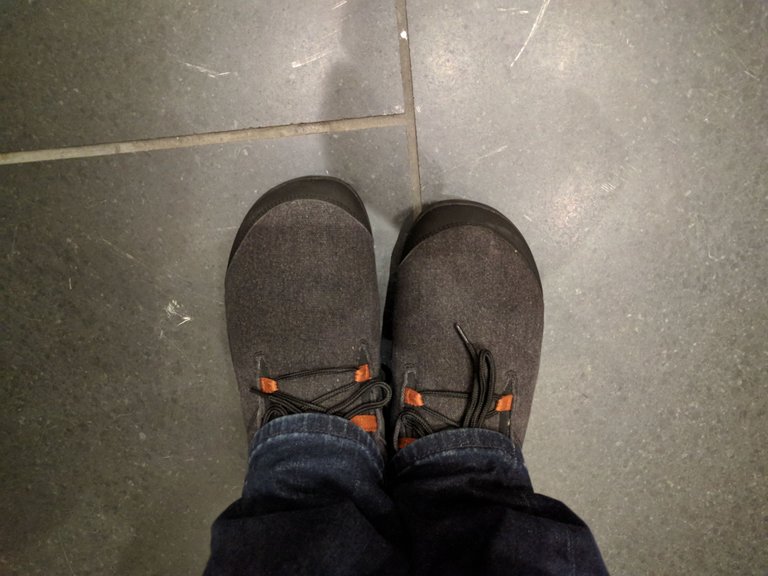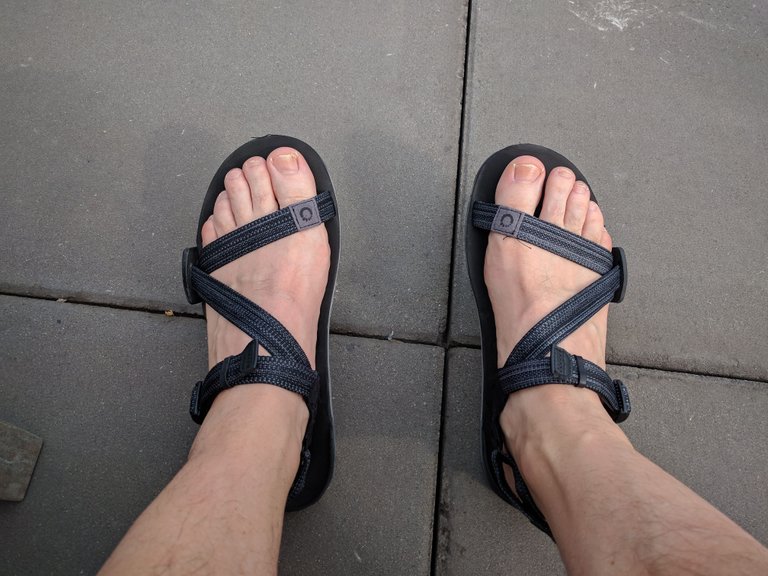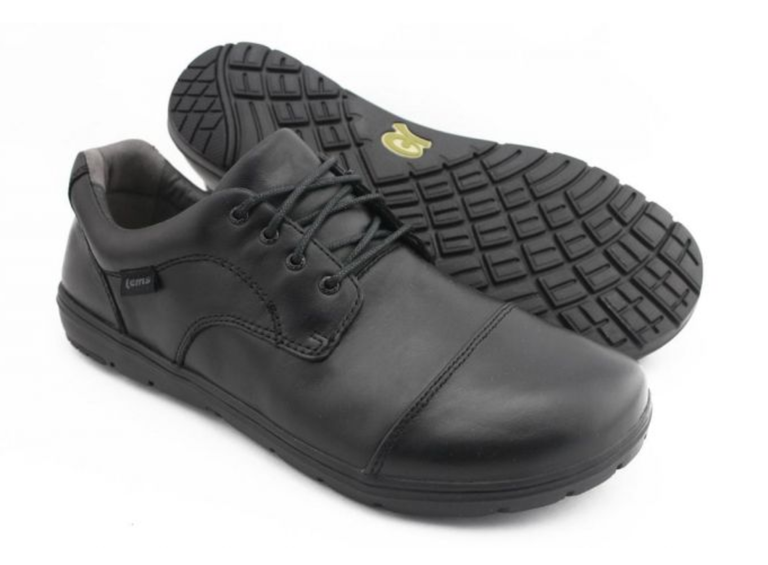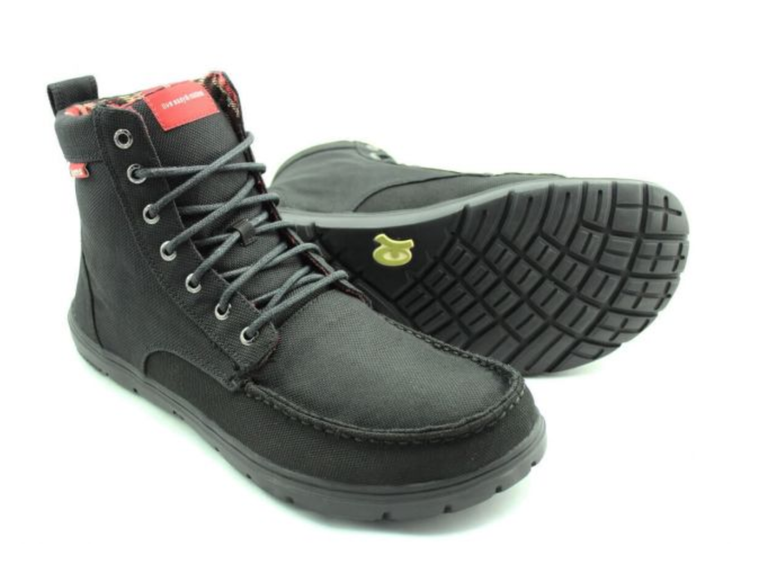I recently bought myself a pair of zero-drop minimalist sandals and shoes from Xero Shoes. In fact, I was so enamoured with the whole concept and their company story that I actually invested a small amount of money in that company. That detail aside I wanted to explain how I got to that point and why I now consider myself "a believer" in the minimalist shoe "fad". Since it started around 1999 I think at almost 18 years old it probably no longer qualifies as a fad and as I'll mention later it is probably no more "fad" like than the original running shoe "fad".
Barefoot begins
In 1999 the first "barefoot" shoe was proposed to the CEO of Vibram shoes and a "fad" was born. Long before that in 1960 Abebe Bikila ran barefoot to win the first of his many marathon medals. In 2005 Vibram FiverFingers were put on sale. In 2009 Christopher McDougall published his book "Born to Run" and the rest, as they say, is history. McDougall followed it up with a TED Talk in 2010:
Having personally seen many "five fingers" shoes in stores and occasionally on other people or even friend's feet I was aware of this "barefoot" running phenomenon. Eventually, I stumbled on McDougall's TED talk above and watched it.
Since I had not been running for several years at the time I wasn't particularly interested in trying literally barefoot or just minimalist footwear for running. However, I was aware that when I first started running I did have a number of muscle and joint pains. I found that my left foot especially was prone to pronating - heel striking on the side of my heel. This lead to shoes that would wear quickly on one heal. I also would get "shin splints" on that side, partly from that and partly from inadequate warm up. Eventually, I got different shoes that supposedly offered better ankle support and resistance to pronation. Things got better but I ended up training only on a soft, bouncy treadmill vs. hard asphalt sidewalks and streets.
My "Aha" moment
So fast forward about 10 years and I'm driving to a park where I regularly hike several miles and 1500 feet vertical with a 40-pound backpack. I put on my favorite Freakonomics podcast to pass the time and low and behold the latest edition is called These Shoes are killing me. So I listen to the podcast and a lot of what is said resonates with me. Humans evolved to walk and run chasing our dinner until it drops with exhaustion. And we did all of that without modern uber-padded running shoes. While some kind of "shoe" has been existence for a long time it was usually very minimal to protect the foot from sharp objects. The podcast also talks about running injuries, the more recent running shoe fad, and the birth of the barefoot running and minimalist shoe "fad".
The basic premise of the show is that all these fancy running shoes probably aren't doing much for you and maybe even harming you simply because they force you to walk with an unnatural posture with a heel strike vs mid or toe strike.
Fast forward a couple more months and I go on a weekend trip to Vegas. I'm staying at a fancy hotel with a nice gym and some of my fitness minded friends decide they want to hit the gym for a bit. It's been a long time since I was at a gym (I actually used to run 10K distance and workout quite a bit, but not in a while) so complain I don't have any running shoes yadda, yadda, yadda. In the end, I decide I'll just put on my Keen sandals which I've hiked many a mile on beaches any some mountain areas with no issues. I think I'll just do a walking pace on the treadmill and listen to some music etc. If nothing else it will burn off some calories from the previous night's excesses.
After a bit of walking on the treadmill, I'm actively thinking of that Freakonomics podcast and wondering if I can maybe take it up a notch. Pretty soon I'm running, going up a 20% incline, and then I lower it again and start ramping up the speed. Before I know it I'm running an 8-minute mile pace in sandals! And you know what, I complete an whole hour of walking and running with no issues at all. Feet feel just fine, no blisters, no muscle or joint problems, all in $60 sandals I've previously only worn for schlepping around on hot days or at the beach.
A couple of weeks later I go on a Sierra backpacking trip and take my sandals and wear them a lot. Not actually for the main hike with a heavy backpack, but more than I'd normally do. By the end of the trip I notice that I've separated the uppers from the soles and I probably need to think about replacing them (they've got to be at least five if not more years old now). Also, my hiking boots have bashed so many rocks that they are also needing to be replaced - they are also way more than five years old, if not ten.
Now I'm thinking... maybe I don't actually need heavy hiking boots and maybe I can get some real minimalist sandals. When searching for minimalist shoes I come right to [Xero shoes](Xero Shoes: https://xeroshoes.com) and I see some nice sandals. I also see they have regular canvas street shoes. So I end up ordering a pair of each:


Reading around I find that the two features of their sandals and shoes which they attribute to them being "minimalist" are
- Zero drop
- Foot shape toe box
The first being that the padding under the heel is no more than the rest of the foot. This is the feature that leads to you tending to foot strike that is more mid to toe strike vs a heel strike. Since I pronate anyway it seems anything that makes me use my heel less is a great idea. The latter feature is where the front of the shoe is much wider than "normal" shoes which tend to constrain the toes to a more restricted area. That can lead to toes that end up misaligned, bunions, blisters etc. etc. Obviously, with a sandal, your toes have lots of room to spread but in most shoes, there is ultimately some constraint width wise. However, Xero Shoes say you can even wear toe spacers if you want. These a silicone pads that site between each toe and spread them apart.
Running, walking, and even hiking "barefoot"
After ordering my sandals and day shoes (I walk about 2 miles each day on my commute) I decide to see if there are minimalist running shoes. When I start searching for that I quickly discovered a bunch of posts debating lightweight hiking shoes vs. the traditional heavy-weight shoes, in particular, there was a lot of debate over ankle support.
My take on this is:
a) there is no definitive answer
b) there's quite a bit of support to say that many boots offering "ankle support" a best are over-rated, and at worst offer no benefit at all
c) if you are really bothered you can still get minimalist hiking shoes and wear separate rigid ankle supports.
Some theories for minimalist hiking shoes (vs. boots) are
a) since the sole of your shoe will not be hard and rigid the foot will not roll around so much
b) your ankle will do more work and the muscles and tendons around it become stronger
c) stronger ankles means fewer injuries
d) lighter shoes means a lot less effort hiking and lifting heavy shoes each step. You might easily save a pound per foot.
I've not come across and peer-reviewed study that claims minimalist shoes are worse than regular hiking boots - mostly any negative comments play on fears of ankle injuries. But data seems to say that most soft hiking boots, which are by far the most popular due to weight and comfort) offer little to no ankle support anyway. My current worn out boots are of the category anyway.
At the moment Xero Shoes do not offer any hiking boots but they say the expect some this fall. In the mean time if you're looking for hiking boots you could take a look at Lems Shoes who offer the Boulder Boot. It has a wide toe box, a decent amount of sole thickness and padding to stop sharp rocks hurting you and they even have a vegan option. I think I'm going wait a bit and wear my day shoes some more before I commit to spending $100 on boots.

I do like that Lems Shoes have a less casual, almost dress shoe Nine2Five - I'll definitely look into getting some of those:

As I said I don't do much running anymore - mostly walking and hiking. However, minimalist running shoes are still very much in vogue. Website Runner Click has a 2017 review of the best zero-drop running shoes. The company Altra Running also has a lot of options in zero-drop running shoes including some mid-height trail shoes and everyday shoes.
If you want an even wider selection check out Zappos "zero drop" and "minimalist" shoe selections.
Contrarian opinions
Not everyone is so enamored or convinced that "barefoot" or "minimalist" shoes are the be-all and end-all of good shoes. In 2012 the New York Times published an article [efficiency for running](https://well.blogs.nytimes.com/2012/10/15/myths-of-running-forefoot-barefoot-and-otherwise/?_r=0] arguing that there is no data that barefoot is better for running. Indeed the claim that running with a few millimeters of padding uses a few percent less energy than running with none at all. They also claim that the worlds best runners have a great variety of foot-strikes and no real correlation to being best.
In terms of injuries, well you can definitely read people giving personal experiences of switching to minimalist footware and eliminating all kinds of muscle and joint issues. And you'll find people saying that doctors are now seeing more people presenting with injuries after barefoot running. As Xero Shoes mention that's not surprising since more and more people are starting to run "barefoot" or minimalist. Doctors also don't see all those people who stopped getting injuries after switching. You can read the rest of their answers to common anti-barefoot issues here: https://xeroshoes.com/barefoot-running/barefoot-running-is-bad-for-you/ and yes they include "OMG, what if I step in dog poop!?" which apparently is a common question. Answer - you wont step in dog poop any more often that you do already.
Then [this Pain Science article]([ Prospective comparison of running injuries between shod and barefoot runners) gives a timeline of barefoot running and cites studies in 2012 through 2016 that seem to back up that barefoot running is better for you in terms of injury rates.
- Foot strike and injury rates in endurance runners: a retrospective study.
- Prospective comparison of running injuries between shod and barefoot runners
It also mentions that 2014 Vibram settled a class action lawsuit and removed all claims about their toe shoes strengthening feet and lowering injury rates until that could be proved scientifically. Checking their website now I don't see any such claims in their FAQ so perhaps they are not yet confident of the benefits.
And finally
These thoughts are my own, I encourage you to do your own research. I've been impressed enough with my two pairs of Xero Shoes to invest a little in their company which is part of a fund raising activity to help them expand their range. Of particular note about Xero Shoes I liked that it has a husband and wife team running the company. I like that they were on Shark Tank and turned down a low-ball offer for the company and went it alone and have done very well since. I like that they are growing the company organically without a lot of marketing expenditure and the founders and executives take very modest salaries - plus it helps to live in Colorado too :-)
If you try out some minimalist shoes or are already rocking some why not chime in below? I'm sure there are a few of us out there on Steemit.
Sources
- Altra Running: https://www.altrarunning.com
- Chris McDougall "Born to Run": http://www.chrismcdougall.com/born-to-run/
- Lems Shoes: https://www.lemsshoes.com
- Xero Shoes: https://xeroshoes.com
- Zappos "zero-drop" list: http://www.zappos.com/zero-drop-shoes
- Zappos "minimalist' list: http://www.zappos.com/minimalist-shoes
Great article, thanks for sharing your own experience! Since a year back I walk around & exercise barefoot as much as possible. After just a few weeks it became very obvious how good this was for the muscles in my feet. I also suffer from stiff ankles due to a life of inactivity, and that's starting to loosen up as well. Feels absolutely amazing and I strongly recommend being barefoot as much as possible, especially for everyone with a sedentary lifestyle.
Wow dude. Very in depth post and totally deserving of the love you're getting. There was a South African athlete by the name of Zola Budd Pieterse that would also only run barefoot and did pretty well if my memory serves.
Indeed. And weirdly I was just having a discussion about her this evening - she did great until apparently kicking Mary Decker in the 1984 Olympics and then it wasn't so great afterwards. However that was nothing to do with her barefoot running :-)
I didn't know about that. Just checked out the Wikipedia article and apparently Decker later said that there was nothing deliberate about what happened.
Interesting story though and probably something I never would have know if not for Steemit.
Oh wow, thanks for all the upvotes fellow Steemians. I'm amazed at the appreciation from the Steemit community and glad you found the post interesting and upworthy!
I have followed you on Steemit, please be kind enough to follow me as well.
Nice.. Upvote for you. Do check my recent post and please upvote/comments.
https://steemit.com/travel/@feel.good/incredible-gokyo-everest-trek-himalaya
Congratulations @o1o1o1o! You have completed some achievement on Steemit and have been rewarded with new badge(s) :
Click on any badge to view your own Board of Honor on SteemitBoard.
For more information about SteemitBoard, click here
If you no longer want to receive notifications, reply to this comment with the word
STOPThanks for this, and the video you posted. I've been wearing Skora zero-drop shoes for about two years now, and I've only recently gotten back into running for exactly what the guy in the Ted talk said - for the fun factor. It's because I love how it feels! Granted I run on trails in the woods that are soft and covered with pine straw. It wasn't really my intention to pick up running again, but as I got more and more into feeling my whole foot on the ground it kind of naturally evolved from walking to dancing to running. Using the zero drop shoes, I feel more in touch with the ground, like I am giving it a massage with my feet!